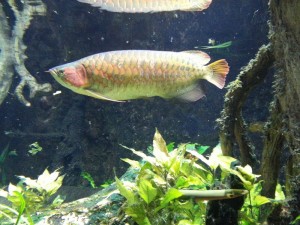Ecosystems in Balance, From Local to Global, Knowledge into Action, Sustainability Inside and Out, Sustainable Seafood, To Conserve and Protect
Caroline Koller
The New England Aquarium is not only an attraction but also a research institute and an educational platform. It provides services for teachers, such as educational films and classroom activities about fish, as well as specialized tours for youth groups and girl/boy scouts (“Classroom Resources”). As a multi-faceted organization, it tries to get every visitor involved through interactive exhibits like ray petting, or through the lecture series for more serious customers. This series will soon be featuring presentations on the illegal turtle trade in the Philippines and a discussion on biomimicry, a phenomenon that could help solve certain human medical problems (“Aquarium Lecture Series”). As for research, the aquarium participates in projects all over the world. For instance, they are involved in cold-water aquaculture in Newfoundland in addition to stranded animal rescues along the East Coast (“Endangered Species and Habitats”).
One of the projects I personally find the most interesting is one of the ones that is most relevant to the aquarium as a business: ornamental aquaculture, or farming fish not for food but for human aesthetic enjoyment. This practice is generally viewed favorably, because it is widely known among environmentalists that collection of exotic fish species is often damaging to their limited populations. Additionally, collection techniques can be harmful to the individual fish because of the delicate nature of many of the species that are prized in aquariums. Finally, since the aquaculture fish are already used to living in captivity, they are less likely to suffer once they actually arrive at the aquarium (Tlusty 2004).
On the other hand, Michael Tlusty, a researcher at the aquarium, warns us not to let our enthusiasm go unchecked when it comes to ornamental aquaculture. As an industry, it is thought to be on the brink of rapid growth, and its environmental impacts have not been fully assessed, especially with regard to nutrient loading in areas without strong currents to disperse waste (Tlusty 2004). In terms of species conservation, ornamental aquaculture can be harmful because higher numbers of exotic species in aquariums can be correlated with increased demand for their wild fished counterparts, since the species are viewed as abundant and their popularity increases. Another issue with ornamental aquaculture is an economic one. Some critics of the industry say that increased availability of previously rare species will drive down prices, eventually causing fishermen to lose money. In that case, the fishermen would have to catch even more of the rare species, driving the populations of some endangered species down further (Tlusty 2004). Finally, as with aquaculture for food, there are problems of escapement and invasive species. Several incidences of this happening due to ornamental aquaculture have been recorded, mainly in North America (Tlusty 2004).
Aquariums must necessarily import exotic fish species, but they are also a strong voice for sustainability and environmental protection. It is for these reasons that the New England Aquarium is involved in research on how best to mitigate the negative effects of ornamental aquaculture.
Austin Duncan
The New England Aquarium, which opened in 1969, is one of the world’s top ocean exploration and marine conservations. The aquarium’s mission to combine education, entertainment, and action in order to address challenging problems facing the world’s great unknown helps attract over 1.3 million visitors a year. Being the only Boston-based cultural institution, the aquarium promotes the importance of protecting the ocean through various exhibits and educational programs (New England Aquarium: Mission). The aquarium prides itself on providing visitors the opportunity to explore the oceans and see a wide variety of marine animals in various levels of world class exhibits. Because of its unparalleled resources and commitment to the betterment of the environment, the establishment is at the forefront of research and outreach activities.
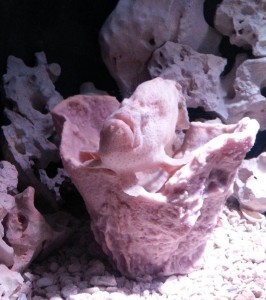
This angler fish fits right in with its habitat. They use camouflage to conceal themselves from prey as well as predators.
One of the main focuses of the New England Aquarium outreach programs is endangered species and habitats. The aquarium uses a collaborative effort to limit human impact on ecosystems and conserve threatened animals and habitats (New England Aquarium: Endangered Species and Habitats). The Endangered Species and Habitat Program has successfully helped ecosystems through aiding in the “creation of the world’s largest Marine Protected Area” (New England Aquarium: Endangered Species and Habitats). Additionally, the program possesses the ability to breed and raise various threatened or endangered species behind closed doors (New England Aquarium: Endangered Species and Habitats).
The aquarium displays a commitment to bettering ecosystems through projects which help preserve many endangered species. One of which is Project Piaba. Established in order to promote “environmentally and socially beneficial ornamental fish trade” (New England Aquarium: Project Piaba). The project began as a research program, which possessed the mission of monitoring cardinal tetra and other ornamental fishes in the Brazilian Amazon (New England Aquarium: Project Piaba). Communities that maintain a market for selling aquarium fish protect the resources that sustain them. Project Piaba “fosters the sustainable trade in wild-caught aquarium fish” (New England Aquarium: Project Piaba). The aid that Project Piaba provides fosters communities to protect both rivers and forests, in turn protecting all the creatures they inhabit.
In order to further Project Piaba’s goal of fostering environmentally and socially beneficial ornamental fish trade, an annual expedition is held in January. This expedition is part of “Project Piaba’s long term study of the Amazon fishery for the global home aquarium fish” (New England Aquarium: Project Piaba). Every year Project Piaba makes the trek to Brazil’s Rio Negro in the Amazon where they spend two weeks aboard a boat observing all facets of the home aquarium fishery. The expedition includes visits to local hotspots, fishing communities, and participation in the Ornamental Fish Festival of Barcelos (Project Piaba: Upcoming Events). As a whole, the New England Aquarium is a frontrunner in the development and implementations of new solutions to preserve oceans and ecosystems across the world.
Charles Grant
The New England Aquarium in Boston is a global leader in ocean exploration and marine conservation (About us). It goes above and beyond a traditional aquarium by combining education, entertainment, and action to address the most challenging problems facing the ocean (About us). The aquarium is highly respected because of its educational initiatives as well as conservation projects. Conservation and research projects include protection of endangered species and habitats, bycatch, fisheries, aquaculture, and climate change. Each category contains a multitude of individual programs that concentrate on a particular area of need (About us).
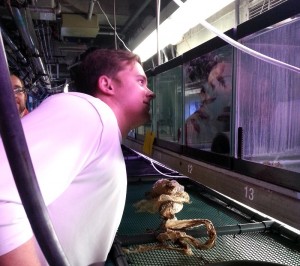
James gets up close and personal with a tank of fish behind the scenes as our guide tells us about Project Piaba.
One of the aquarium’s projects was to foster an environmentally and socially beneficial ornamental fish trade called Project Piaba. The project grew from a long-term research program that monitored the cardinal tetra, a popular fish for home aquariums, and other ornamental fishes in the Brazilian Amazon (Project Piaba). Furthermore, by selling and re-growing fish for the aquarium trade, local communities protect the resource that sustains them. This is the major focus for Project Piaba, as sustainability of the trade in wild-caught aquarium fish is fostered by encouraging people to safeguard both rivers and forests, and all the creatures they harbor (Project Piaba).
In developing countries, the most profitable industries are often the most destructive; however, aquaculture has the potential to be both profitable and environmentally friendly. A number of economic, legal, and social trends support the notion that aquaculture is a profitable, productive, and sustainable economic activity. For example, there is continued industry interest in developing methods for cultivation of new species as the demand for a wide variety of ornamental fish is high. The aquarium’s project is one of several advancing aquaculture of marine species for sustainable purposes, indicating that others also think it a successful environmentally sustainable activity. Project Piaba can help sustain the local ornamental fish industry, restore exploited and impacted wild populations of fish, and minimize adverse effects associated with overfishing (Project Piaba). In addition, mounting legislation from conservation groups and governments restrict the collection of wild organisms, which leaves aquaculture as the best means to satisfy market demand for ornamental fish (Project Piaba).
Iain Edmundson
The New England Aquarium is a global leader in ocean exploration and marine conservation. Annually, it has over 1.3 million visitors and functions as a major education resource for informing the public not only of the beauty of nature, but also the importance of protecting it. They strive to combine education, entertainment and action to help address the challenges the oceans face today (About Us: An Overview). Not only does the aquarium function as an educative tool however, they are also “a global leader in ocean exploration and marine conservation.” Through their conservation and research programs, they are developing and implementing “new solutions to protect the oceans and balance the human impacts on the.” These programs include support of sustainable fisheries, research on climate change and the oceans and a marine animal rescue program (Conservation and Research) which is highlighted by their status as a global leader in saving endangered turtles (Animals and Exhibits). One of their most recent initiatives to help further their mission is the live blue initiative.
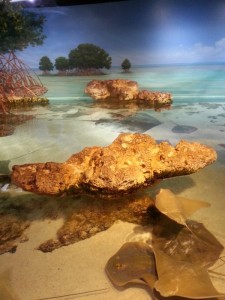
The Sharks and Rays touch tank is a great resource to get kids excited about the oceans. Adults think it’s pretty neat, too.
“We don’t inherit the planet from our parents; we borrow it from our children” (What You Can Do to live blue). This pre-verb very directly addresses why the live blue initiative is so important. In the live blue outreach section of their Conservation and Research department, the Aquarium details some of the things people can do to help the oceans. Since “the way we each live our lives contributes heavily to climate change” and a number of other issues regarding the oceans, it really comes down to the public taking action in order for there to be any true change. This is what the live blue initiative is trying to do, go straight to the public and inform them on ways to make a difference regarding the health of the planet, including buying fuel efficient vehicles, choosing energy-saving appliances, exploring the aquatic world, choosing ocean-friendly seafood and actively supporting the Aquariums conservation efforts (What You Can Do to live blue).
In order to accomplish this goal of informing the public, they have an entire page devoted to information on how the public can change their ways in order to be more environmentally friendly. Firstly, they have numerous methods for reducing carbon emissions such as choosing a fuel-efficient car and installing energy saving thermostats and appliances. They even include a Carbon calculator to allow people to calculate and track their carbon emissions, and suggestions on how to reach your conservation goals with things like Energy star, the Union of Concerned Scientists and more (What You Can Do to live blue). Another great feature of this program is their list of sustainable seafood options which not only includes the best seafood to be eating, but also great recipes to make the transition to a more sustainable lifestyle more smooth (Ocean Friendly Seafood Species). Probably one of the most important things that they include however, is the Aquarium and details on new programs and exhibits where people can go to see why what they’re doing is important and why they should care about conservation efforts. In order to ensure that people are being effectively communicated with, they even have an available quarterly magazine and an email Newsletter helping to further remind people of the importance of their conservation efforts (What You Can Do to live blue). All of this combines to help the aquarium reach its core goal as it educates and entertains people in order to see progress with the many issues our oceans face today.
Julia Liu
The New England Aquarium is a private, nonprofit aquarium in Boston that serves as a cultural institution to help visitors in the area learn and connect with their neighboring ocean (Aquarium History, 2015). The New England Aquarium’s goal is to educate, entertain, and inspire visitors to take action about marine issues. The Aquarium offers many programs for families and youth that include summer camps and visiting lecturer programming. Since 1972, the Aquarium has provided free programming of lectures and films from environmental leaders and scientists for visitors (Aquarium Lecture Series, 2015). The NEA also does outreach in nearby community areas by setting up Aquarium Open Houses upon request as well as three specific community outreach programs: the Lobsters Program, Traveling Tidepool Program, and Sharks Program (Community Programs, 2015). In addition to the outreach, the aquarium also has a bustling online community. The NEA runs a series of blogs and webcam series that follow exciting marine animals and expeditions (Blogs, Videos, Webcam and More, 2015). Additionally, the aquarium releases an e-newsletter called SeaMail to keep subscribers updated with the aquarium news (Blogs, Videos, Webcam and More, 2015).
In middle school and high school, I participated many summer camps over the years and so the NEA Summer Programs sparked my interest. One summer program in particular, the Harbor Discoveries Camp, seemed like something I would’ve been very interested in participating in. The Harbor Discoveries Camps, which started in 1996, are a series of hands-on environmental marine programs that involves aquarium activities as well as field trips to nearby habitats in the Boston Harbor Islands National Recreation Area. These summer camp programs are meant to inspire appreciation and stewardship (Harbor Discoveries Camps). There are junior programs, senior programs, and advanced programs for kids of different ages. The advanced programs for teens stood out to me as amazing hands-on opportunities for youth interested in marine science. The Aquarist in Training program focuses on marine animal care while the Intertidal Studies program emphasizes scientific study via tide pooling out in the field (Advanced Camps, 2015).
These weekly camps are action-packed Monday through Friday. Two out of the five days of the camp are spent at the Aquarium and three days are spent out at field sites. Some activities include visiting the James Hook Lobster Company, Lovell’s Island in the Boston Harbor, Northeastern University’s Marine Science Center, and overnight camping trips at the Shawme Crowell State Park, Grape Island, etc. (Junior Camps, 2015). This Harbor Discoveries program really exemplifies community partnership by connecting community members to local fishery and marine organizations. Programs like the Harbor Discoveries Camps deserve recognition as a step in the right direction for the health of our oceans by connecting members of the general public to marine issues and education.
Tegwyth Alderson-Taber
The New England Aquarium, opened in 1969, is now a global leader in ocean exploration. The Aquarium is a big visitor attraction in Boston, with over 1.3 million visitors per year. It is also a major public education resource. “The Aquarium is redefining what it means to be an aquarium: combining education, entertainment and action to address the most challenging problems facing the ocean. Through a wide variety of educational programs and conservation initiatives, we make a lasting impact globally” (http://www.neaq.org/about_us/index.php) In order to make this lasting impact, the aquarium has many resources, activities, and programs they promote. Some of the aquarium’s main focuses are: endangered species and habitats, climate change and the oceans, sustainable fisheries—bycatch and aquaculture, marine animal rescues, and conservation and ocean health.
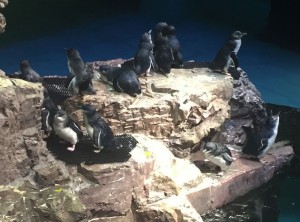
Penguins draw in many visitors. These may look like babies but they are full grown. Photo Credit: Star Guland
The Aquarium also focuses on education and outreach to all of New England. It provides in-depth educational resources and activities for both teachers and parents, but also promotes hands-on learning in the aquarium itself. Teaching is a very important aspect of building our future and without teaching kids the importance of marine life and the oceans seventy percent of our world could be destroyed.
One of the aquarium’s education programs is called Blue Impact. It is a video series that presents the challenges ocean animals face from global climate change, and how communities are coming together to make a difference for our oceans and our world. The video series is geared towards younger children and does not cost anything to access meaning any school, teacher, or parent can easily teach their children what is happening to the world and how we can fix it. The Blue Impact series also has a way for any community to share what they are doing to help the earth like minimizing energy use. This gives kids and families an incentive to do something about climate change because if they document it and post the video or photo on any social media with #blueimpact the New England Aquarium might post it to their website and give that family or community some recognition. Targeting this education towards young children is a great way to not only change their actions but also change the actions of whole families.
More Posts
Ecosystems in Balance, From Local to Global, Knowledge into Action, Sustainability Inside and Out, Sustainable Seafood, To Conserve and Protect


